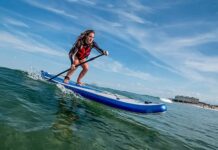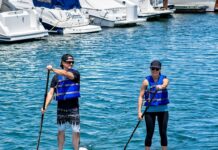In this article, we explore the potential benefits of Stand-Up Paddleboard (SUP) fitness as a rehabilitation exercise following an injury. We delve into the unique combination of core strength, balance, and low-impact movements offered by SUP fitness, and how these factors contribute to its potential effectiveness in aiding the recovery process. So, if you’re looking for an engaging and enjoyable way to get back on your feet after an injury, SUP fitness might just be the perfect fit for you.
Overview of SUP Fitness
Definition of SUP Fitness
SUP fitness, short for Stand-Up Paddleboard fitness, is a form of exercise that combines paddleboarding with various fitness activities. It involves performing exercises and workouts on a paddleboard while navigating through water. SUP fitness has gained popularity in recent years due to its unique combination of cardiovascular exercise, strength training, and balance challenges.
Benefits of SUP Fitness
SUP fitness offers a wide range of benefits for individuals seeking rehabilitation after an injury. It provides a low-impact yet challenging workout that can aid in the recovery process. Some key benefits of SUP fitness for rehabilitation include improved balance and stability, enhanced joint mobility, strengthened muscles, improved cardiovascular fitness, and boosted mental well-being.
Rehabilitation Exercises after Injury
Importance of Rehabilitation
Rehabilitation plays a crucial role in recovering from an injury, whether it is a sprained ankle, a shoulder injury, or any other musculoskeletal condition. It helps restore function, reduce pain, and prevent future injuries. Proper rehabilitation exercises can improve strength, flexibility, and overall movement. They also help individuals regain confidence in their abilities and promote a smooth transition back to normal activities.
Types of Rehabilitation Exercises
Rehabilitation exercises can be categorized into three main types: stretching and flexibility exercises, strengthening exercises, and functional exercises. Stretching and flexibility exercises aim to increase the range of motion and improve muscle flexibility. Strengthening exercises focus on rebuilding muscle strength and endurance. Functional exercises involve specific movements that simulate real-life activities and help individuals regain functional abilities.
Understanding SUP Fitness as a Rehab Exercise
What is SUP Fitness?
SUP fitness combines the benefits of paddleboarding and fitness training into a single workout. In SUP fitness, individuals perform a variety of exercises and activities, such as squats, planks, yoga poses, and paddling drills, while standing on a paddleboard. This unique environment challenges the body’s balance, stability, and core strength, making it an effective rehab exercise.
Relevance of SUP Fitness in Rehabilitation
SUP fitness is particularly relevant in rehabilitation due to its ability to provide a low-impact workout that minimizes stress on injured joints and muscles. The instability of the paddleboard surface forces the body to engage smaller stabilizing muscles, which helps improve overall balance and stability. Additionally, the soothing effect of water and the rhythmic motion of paddling can contribute to the relaxation and recovery of injured tissues.
Benefits of SUP Fitness for Rehabilitation
Improves Balance and Stability
One of the key benefits of SUP fitness in rehabilitation is its ability to enhance balance and stability. The unstable surface of the paddleboard challenges the body to constantly adjust and engage various muscle groups to maintain balance. This helps individuals regain control over their movements and stabilize injured areas.
Enhances Joint Mobility
SUP fitness can also contribute to improving joint mobility during the rehabilitation process. The movements involved in paddleboarding, such as paddling and performing exercises on the board, require a wide range of joint movements. This promotes flexibility and helps prevent stiffness in injured joints, facilitating better recovery.
Strengthens Muscles
SUP fitness is an excellent way to strengthen muscles without subjecting them to excessive strain. The resistance provided by the water and the need to maintain balance engages multiple muscle groups simultaneously. This can aid in rebuilding muscle strength and promoting overall muscular development during the rehabilitation phase.
Enhances Cardiovascular Fitness
Engaging in SUP fitness can have a positive impact on cardiovascular fitness during the rehabilitation process. The combination of cardiovascular exercise and resistance training provided by paddleboarding results in an effective full-body workout. This can help improve heart health, increase endurance, and promote overall cardiovascular fitness.
Boosts Mental Well-being
Rehabilitation can be a physically and emotionally challenging process. SUP fitness offers a unique outdoor experience that combines the benefits of exercise with the calming effects of being on the water. This combination can help reduce stress, improve mood, and boost mental well-being during the rehabilitation journey.
Considerations for Using SUP Fitness for Rehabilitation
Individualized Approach
When incorporating SUP fitness into a rehabilitation program, it is crucial to adopt an individualized approach. Each person’s injury and rehabilitation needs are unique, requiring tailored exercises and modifications. Consulting with a healthcare professional or a qualified instructor can help ensure the exercises are appropriate and safe for the individual’s specific condition.
Safety Precautions
Prioritizing safety is essential when using SUP fitness for rehabilitation. It is important to wear appropriate personal flotation devices (PFDs) and ensure the paddleboard is stable and in good condition. Taking precautions, such as avoiding rough waters or extreme weather conditions, can minimize the risk of accidents.
Qualified Instruction
Working with a qualified SUP fitness instructor or physical therapist who has experience in rehabilitation can provide valuable guidance and support. They can help design a customized program, monitor progress, and provide feedback and modifications as needed. Professional guidance ensures that the exercises are performed correctly and safely.
Progression and Monitoring
Progression and monitoring are key aspects of using SUP fitness for rehabilitation. Gradually increasing the intensity and complexity of exercises ensures a progressive and effective recovery process. Regular monitoring, both self-monitoring and input from professionals, helps adapt the program to individual needs, track progress, and make appropriate adjustments when necessary.
Case Studies and Research Evidence
Case Study 1: SUP Fitness for Ankle Sprain Rehabilitation
In a case study conducted on individuals with ankle sprains, SUP fitness was found to be an effective rehabilitation method. The participants underwent a supervised eight-week training program that included balance and stability exercises, paddling drills, and functional movements on a paddleboard. The results showed significant improvements in balance, ankle strength, and functional abilities, indicating the potential of SUP fitness as a rehabilitation tool for ankle sprains.
Case Study 2: SUP Fitness for Shoulder Injury Rehabilitation
Another case study explored the use of SUP fitness as a rehabilitation tool for shoulder injuries. Participants with various shoulder conditions underwent a six-week program that incorporated paddleboarding, specific shoulder exercises, and stretching. The findings revealed increased shoulder range of motion, improved muscle strength, and a reduction in pain levels. This suggests that SUP fitness may have positive effects on shoulder rehabilitation.
Research Evidence on SUP Fitness as a Rehab Exercise
Emerging research supports the efficacy of SUP fitness as a rehab exercise. Studies have shown that SUP fitness can improve overall balance, core strength, proprioception, and joint stability. Researchers have also found that paddleboarding can reduce lower back pain, improve postural control, and enhance muscle endurance. These findings suggest that SUP fitness offers a promising approach to rehabilitation.
Examples of SUP Exercises for Rehabilitation
SUP Balance Board Exercises
SUP balance board exercises focus on improving balance and stability. These exercises can include standing on one leg on the paddleboard, performing squats or lunges while balancing, or incorporating yoga poses that challenge stability, such as the Tree Pose or Warrior III.
SUP Paddling Drills
SUP paddling drills help enhance upper body strength and cardiovascular fitness. These drills can involve paddling at different intensities and speeds, performing intervals of high-intensity sprints, or incorporating specific paddle strokes to target different muscle groups.
SUP Yoga Poses
SUP yoga poses combine the benefits of yoga with the challenge of maintaining balance on a paddleboard. Poses such as Downward Dog, Warrior I, or the Child’s Pose can be modified to be performed on a paddleboard. These exercises help improve flexibility, core strength, and mental focus.
Expert Opinions on SUP Fitness for Rehabilitation
Physical Therapist Perspective
According to physical therapists, SUP fitness offers unique advantages as a rehab exercise. The combination of water’s buoyancy and the instability of the paddleboard surface provides an environment that challenges the body without excessive stress on injured areas. Physical therapists recommend incorporating SUP fitness into rehabilitation programs alongside traditional therapy to enhance overall recovery and promote functional abilities.
Sports Medicine Specialist Perspective
Sports medicine specialists recognize the potential of SUP fitness as a rehab exercise. They highlight its ability to engage multiple muscle groups, improve balance and stability, and provide a full-body low-impact workout. Sports medicine specialists emphasize the importance of individualized programs and supervision from qualified professionals to ensure safety and optimize results.
Limitations and Risks of SUP Fitness for Rehabilitation
Limited Accessibility
One limitation of SUP fitness for rehabilitation is its limited accessibility. Not everyone has easy access to suitable water bodies or paddleboarding facilities. This can present challenges for individuals who do not live in coastal areas or have limited financial resources to access paddleboarding equipment.
Weather Conditions and Water Quality
SUP fitness is highly dependent on weather conditions and water quality. Unsuitable weather, such as strong winds or rough waters, can make paddleboarding unsafe or hinder the effectiveness of the exercises. Additionally, water quality concerns, such as pollution or harmful algae blooms, may limit the availability of suitable locations for paddleboarding.
Risk of Falls and Injuries
While SUP fitness can be a safe activity when performed with proper precautions and supervision, there is always a risk of falls and injuries, especially for individuals with existing musculoskeletal conditions. It is important to be mindful of the potential risks and take appropriate safety measures to prevent accidents and minimize the chance of exacerbating the injury.
Conclusion
SUP fitness offers a promising avenue for rehabilitation after injury. Its combination of balance, stability, cardiovascular exercise, and joint mobility makes it an effective and enjoyable rehab exercise. SUP fitness has the potential to improve overall musculoskeletal function, enhance cardiovascular fitness, and promote mental well-being. By considering individual needs, safety precautions, professional guidance, and monitoring progress, SUP fitness can be safely integrated into rehabilitation programs to optimize the recovery process. Despite limitations and risks, SUP fitness can be a valuable tool for individuals seeking an engaging and effective rehabilitation experience.






































